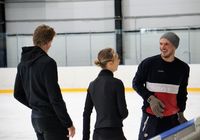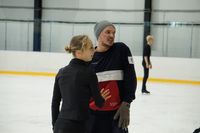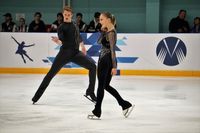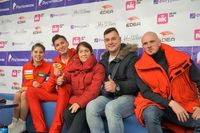Nikolai Moroshkin at a training session with Alexandra Boikova/Dmitri Kozlovski
Nikolai Moroshkin: "We try to be perfect in all aspects."
The young and interesting choreographer Nikolai Moroshkin works in the club of Tamara Nikolaevna Moskivna. This season, for the first time, he choreographed competition programs for a top team, for Alexandra Boikova-Dmitri Kozlovski. Some people probably remember who Nikolai Moroshkin is. He competed in ice dance, skated in Alexei Gorshkov's group and participated in the 2011, 2013 and 2014 World Junior Championships with Evegenia Kosygina. After his career ended in 2015, he began coaching and moved to St. Petersburg. In an interview for figureskating-online.com the choreographer talks about his work with pairs of Moskvina and Minchuk, with single skaters and about the new programs of Boikova/Kozlovski.
*Why do we report on Russian skaters/coaches and publish interviews with them in spite of the terrible war (which is even not allowed to be called war in Russia) in Ukraine? We believe that these horrible events are not the fault of the Russian people and we feel that the civil society in Russia should be strengthened and not excluded.*
When did you start working in Tamara Nikolaevna Moskvina's club?
NM: Since September 2018. That's when I first showed up at Tamara Nikolaevna Moskvina's club. But then I didn't work at all with couples. I was invited to coach in the singles skating group. At that time I was considered to be a person who could very well teach skating skills to kids. Before that, I had worked at the Figure Skating Academy with the younger kids of Evgeni Rukavitsin's group. Then I realized that I wanted to go further, and I had no opportunity to go further in that group, because Rukavitsin has his own group, to which he is loyal. We bid farewell, and literally the next day I was invited to the group of Veronika Daineko for a trial lesson with her kids. Since Veronika Anatolievna very quickly liked everything, I was already employed by the club in October, as far as I remember. I worked very long, fruitfully and diligently with her young athletes. One of them was also Peter Gumenik, who was still very short. I worked with the singles and they started skating better, a hundred percent - great speed, great edges. Everything began to work out. I understand that Tamara Nikolaevna and Artur Leonidovich (Minchuk) noticed this and invited me to work with the little pairs in their group. And so I gradually became part of the staff of the club.
Of course, you, as a former dancer, know about the work within a pair. But still, ice dance and pair skating are a little different.
NM: Totally different! In pairs skating, it's very difficult to find time and space in the programs to add something dancey, flowy, with a realignment in the pairs' moves. As a one hundred percent performance of the pair skating elements is required, there should be comfortable entries into the elements, and there is very little time for any dance moves. And you have to think a lot, and then, unfortunately, you have to take out a lot to be able to do everything. I think that in pairs skating it is very difficult. And the pairs do a very good job to go for this complexity - to combine single skating, the difficult tricks of pair skating and dance moves. We're trying our best.
Nikolai Moroshkin and Alexandra Boikova at a training session
To combine all those things is some kind of challenge?
NM: Definitely a challenge. We have to improve all the time. And not only in the technical elements, but so that it is interesting for the audience. After all, there are different tastes and colors - someone likes complex acrobatic elements, and someone likes the opposite, to have "chemistry" in a pair, but this requires the ability to skate and look each other in the eye, for this too you need some dance moves. We try to please everyone and be perfect in every aspect.
How much does your experience as a dancer help you?
NM: It's actually a very ambiguous situation. Now, reviewing the programs when I skated, I am well aware that I skated very, very bad. I did not have the same understanding as I have now. Thanks to Tamara Moskvina's club, as a beginner, I had many opportunities to watch how Alexander Zhulin and Irina Zhuk were working. I try to memorize as much as possible, to write down, to analyze. And of course Nikolai Morozov contributed a lot. I watched him building the programs, how he interacts with the athletes, how he skates, and I tried to learn everything I could and soak it up like a sponge. Hopefully the dance moves will improve a lot. I am very grateful, because I had the opportunity to watch right up close and personal, and even at some point to communicate with these people, to gather a lot of information.
Now you've already been putting on programs for the leading couples yourself.
NM: Yes, this year. It all started with show programs at the end of the past season for Mishina and Galliamov and for Boikova and Kozlovski. We mounted programs, tried them out, the guys liked them, the audience liked them. And this year I'm very happy that I was lucky enough to do the short and free skating program for Boikova and Kozlovski. I really hope that they will be very well received.
How did you find your ideas for these programs, your vision, how did you build these programs?
NM: I had a lot of conversations with people in the choreography industry. It's good that we have the opportunity in St. Petersburg to fortunately communicate with people like Dmitri Pimanov, who is a director at the Mariinski Theatre and an employee of the Mariinski. Also with people from the Eifman Ballet Company who were with us at the training camp in Sochi - Albert Galichanin and Elena Kuzmina, who work for Eifman. I talked to them about the free program, they helped a lot in choosing the music and ideas for Boikova and Kozlovski.
When we were choosing the free program we settled on Anna Karenina, because the guys are very close to this character and this idea. I came to Albert Galichanin's class by chance and saw how the kids interpreted classical characters. And I realized that they should choose something classical. Anna Karenina was born somehow by itself, because I watched Eifman's ballet on the theme of Karenina this year, and I realized that the guys could very quickly grasp these characters. And we were right, because even Eifman's team, Galichanin and Kuzmina, when working with the guys, immediately noticed that the guys grasp the ideas very quickly, and it looks very plot-driven, interesting, and you get a feel for what they're doing. And as Alexandra has read Anna Karenina and loves classic Russian literature, she knows the plot, knows the script, knows how to feel, how to present herself. The free skating developed in a very spontaneous and interesting way. As for the short program, we've made up our minds.
Alexandra Boikova/Dmitri Kozlovski perform their Short Program at Panin-Kolomenkin Memorial
“Hit the Road Jack" is a completely different style.
NM: It's completely different. We wanted - I wanted to try something completely new for them, move away a little bit from the classic ideas. It was a little complicated at first, because for the guys it's a totally different character, and they're still looking for themselves in it. And I have to insist on it, push it through, push it through. They feel the power, the energy, that's what's close to them. And the music adds that to their skating. But I would like to see more freedom, movement, interaction, skating, so the viewer's eye would not be strained, but relaxed and get the bluesy pleasure out of it. That's where we'll have to work a little more. Valeria Tchistiakova had a lot of input into the short program. Together we discussed the concept, built the choreography. Valeria is a young dance choreographer.
And it's good to have such different programs and to have music to which people skated of course, but not so much.
NM: Not so much. There were programs to Anna Karenina, but not in the way as the guys do.
Bobrova and Soloviev did it, but that was ice dance. Pairs didn't use it.
You took Marinelli's music from the movie, right?
NM: From the movie, yes. The music is very good. The movie is not everybody's taste, it is weaker than the music. But also the guys will show something that no one has shown yet. The level of dramaturgy, which will be in their program, from Dima - no one has shown it. And Dima can show it, it will look very fresh and interesting.
I also really enjoyed their Swan Lake short program last year. They really showed a lot of energy.
NM: I hope they can do it this year as well. With the other characters, too, keep their level of energy.
They did Malaguena well too, it's just that I don't like this music very much. But they also managed to convey that passion, that paso doble, that grit, that precision of movement - they did it well.
NM: It's their quality, their quality that really hooks everyone. Because they skate with their soul, it's not forced. And the audience likes that. And we will try that the guys keep it, and stand out, because it's their main advantage. But in addition to Sasha and Dima, I also work closely with Nastia (Mishina) and Sasha (Galliamov). The programs were mounted by other choreographers, but everything requires a detailed fine-tuning and improvement in some areas. The choreographer gives us an idea, a framework, a template, and we have to decorate it. And you have to change things up a bit somewhere, improve things somewhere, and rework things - that also takes a lot of work.
Yes, and they also have different characters - a waltz and Elvis Presley. I was very surprised when I talked to them and asked which program is closer to them, and to my surprise, Sasha said that the classic image, a waltz, is closer to him, and he thinks that Nastia is closer to Elvis Presley. I thought it was the opposite. They had Queen, but Elvis is different after all.
NM: It is different. The waltz suits them, they look good in a waltz. That's a big plus for them. Also in terms of stepping up to the next level, because they're getting older and need to improve in their skating. In skating, we improve all our lives - from the moment we get up on skates to the last day we're standing on skates. We improve our skating every day. I think the waltz program is an opportunity for them to reach new heights in their skating. And Elvis Presley, I understand the idea came from their Pretty Woman show number. It's sizzling, it's light. And Sasha, of course, is very close to this role.
Nikolai Moroshkin with Anastasia Mishina/Alexander Galliamov, Tamara Moskvina, Artur Minchuk
Are you also working with the new couple - Yasmina Kadyrova and Valera Kolesov?
NM: Yes, they are very interesting and bright guys. Beautiful, I like them. But there are still questions, they are still gelling as a team and it will take some time. And maybe they'll come out quickly as a pair or it'll take a little longer. It's all a matter of time. Their programs were done in spring. As soon as they teamed up pair, while the top teams performed at the Channel One Cup and traveled to shows, Yasia and Valera were already preparing elements, and we were working with them on transitions. The couple was new, unfamiliar, different people, and it took a long time to study them. But we created two very good programs. We changed the short a lot; we were looking for something more classical and for a more modern program. We will try to make them look very nice and not out of place in it. Because the biggest risk here is not to look bad. Carmen is great music, used by a lot of people. And skating well is our responsibility. So we're going to work hard on that.
And with the singles probably continue to work too?
NM: I continue to work with the singles. I'm working very closely with Nikolai Ugozhaev. I gave him two programs that were completely new for him. We worked a lot on his expression, on the quality and speed of his skating, on his nobility, I'll even call it that. To make him stand out from his competitors. Stand out a lot. I hope he surprises. Even more, I hope that he will improve compared to last year, because the judges very often singled him out as very promising, but you can't go far on being promising alone. They are all promising, promising ones come along every day. The important thing is to do that step from being promising to being great. That's where I think we got a little bit of that out of him. I hope he's not just going to show it in practice, because he made a strong impression on the judges that came in, and he looks different than he did in the past years. I hope that he will keep that and improve even more when there is more responsibility and when there will be more spectators.
We also try to help Andrei Kutovoi, so that he does not get lost. He has had a difficult year - injuries, and then the pressure that has been put on him, it weighs on him, we try to ease it all a little bit for him. We'll see. But it's a little bit hard with him right now. But we'll see, there's time. The boys have their moment of greatness each in their own way. And hopefully his is still to come. So here we try to do everything we can for him. Also we have a very promising little girl Sofia Pashko. But as I told you about Nikolai Ugozhaev, she is still at the level of being promising. Therefore, it's very difficult and ambiguous to talk about her as a girl who will give results. We don't know yet how long it will take. There is someone to work with, the boys are all different, all interesting, of different ages. And to work with all ages, with all directions – with girls, boys, pairs -is very interesting and different.
What about ice dance, you don't want to work with dancers anymore?
NM: There is a very big desire to work with ice dancers, for me as a former dancer. Eventually I still want to get to the point when I will be connected in some way with ice dance. However, in our city of St. Petersburg there are not many opportunities in ice dance. It is very difficult. Well, we wait. Life is such a thing - everything changes very quickly. The main thing is not to get discouraged and to adapt quickly.



